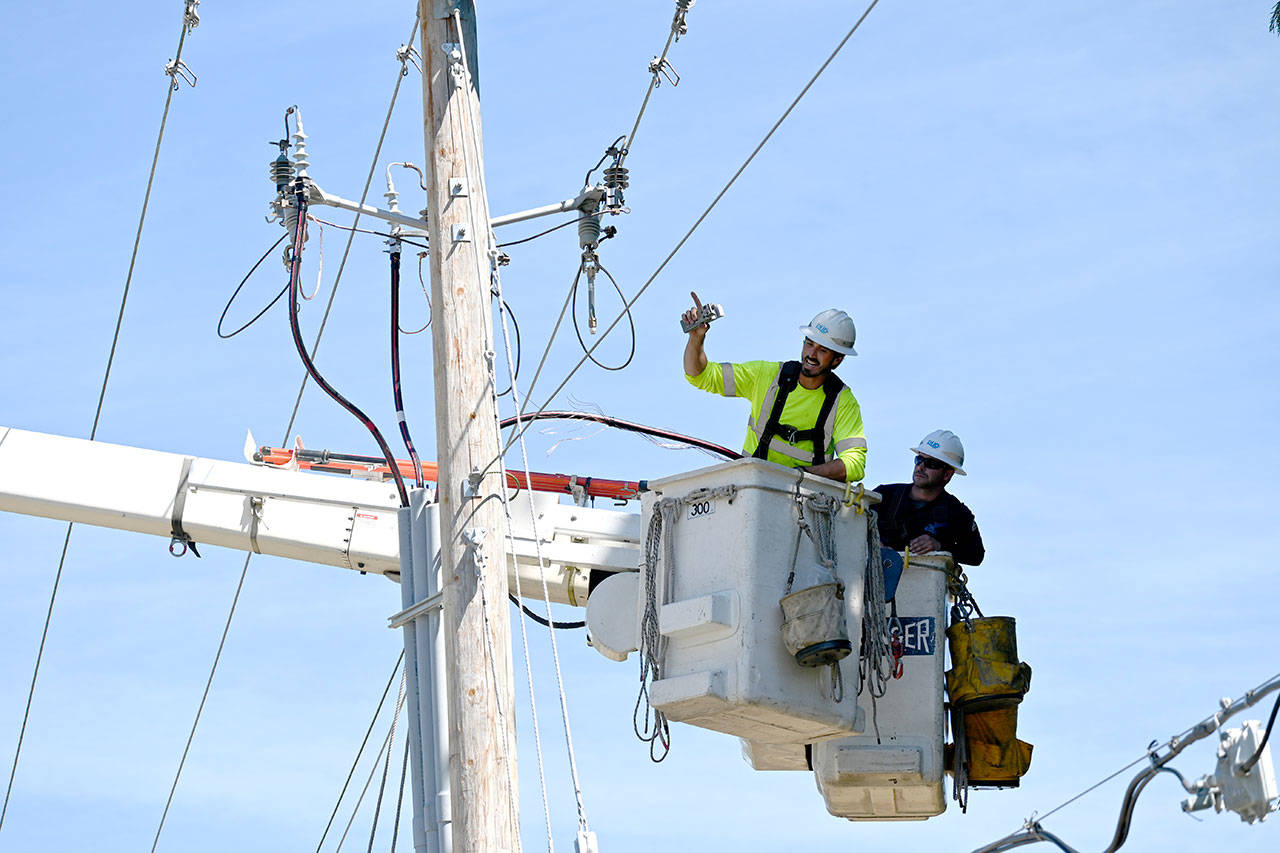SEQUIM — It is now safer to move about the pond.
A multi-agency, private-public effort to help trumpeter swans safely depart from their seasonal home on Kirner Pond is complete.
The project, led by Olympic Peninsula Audubon Society members and aided in partnership with Clallam County Public Utility District, Washington Department of Fish & Wildlife (WDFW), Clallam County’s roads department, residents with adjoining property and WaveCable — not to mention community members who raised funds through a GoFundMe campaign earlier this year — saw the last power line taken down in September, literally clearing the way for the trumpeter swans to take off from the small pond located about a mile west of the Woodcock/Sequim-Dungeness Way intersection.
“It’s a real team effort and (in) a lot of different ways,” said John Acklen, a retired utilities employee and former environmental science project manager who helped coordinate the efforts.
“Usually for project like this, the utility takes it on,” he said. “This had a lot of moving parts. For a small project, it did make it a little bit more complex.”
For years, local bird advocates have recorded a number of deaths — at least eight since December 2014 — of swans as they try to depart from the pond.
Countless others have been injured as well, and in the past 10 years, the lines were the most significant cause of death among the swans in the Sequim-Dungeness Valley, noted Shelly Ament, the local biologist for WDFW, in a previous interview.
Local bird advocates came together to start a GoFundMe fundraiser that kicked off on Jan. 25, and it quickly raised more than the goal of $65,000. Those funds, along with in-kind labor and efforts from Clallam PUD, helped fund the work to bury the power lines.
Ken Wiersma, president of the Olympic Peninsula Audubon Society, said on July 1 that the last property owner had agreed to sign an easement that would allow the project to proceed.
Workers broke ground in early August, and in September, the last utility line was put underground, prepping the pond for the swans’ annual trek to the Sequim area in November.
About 200 to 300 feet long, Kirner Pond is located just north of Woodcock Road. Power lines to the west of the pond generally pose the problem, one that for years Clallam PUD crews have tried to mitigate with deflectors that signal to birds an object to avoid.
However, Bob Phreaner of Olympic Peninsula Audubon Society noted in a previous interview, the 25-pound-plus swans will take off into the wind to get lift, and “in a short stretch like this — it’s about a football field — they need to gain elevation pretty rapidly in order to climb these 30-foot-high wires.”
Noted OPAS representatives, “When their large wingspans and body mass strike the fixed power lines and they fall to the road, swans suffer physical injury and not infrequently short-circuit power lines, resulting in electrocution of the birds.”
Phreaner himself noted a number of power-line strikes, including five in 2020 between Nov. 10 and Dec. 11.
OPAS enlisted the services of local videographer John Gussman, who captured footage of swans striking the power lines.
Acklen said OPAS work such as Phreaner’s to study the swans, Gussman’s video and collaboration with Ament and the PUD’s Mike Hill helped the project come together.
“The video piece was very effective; it galvanized a lot of people,” Acklen said.
“We’re really thankful to a bunch of partners, folks that really, really stepped up for us.
“It all goes back to the public. Folks care about issues like this in our community. There are lot of people who care about the environment … (and) these birds are so impressive.”
OPAS partners with WDFW and the Northwest Swan Conservation Association each winter to conduct weekly surveys of swans in the Sequim-Dungeness area.
The project, which began in the winter of 2011-12, sees volunteers collect data about swan numbers and habitats used for daytime feeding and night roosting.
In late autumn 2020, OPAS, with a crew of about 30 experienced and new volunteers, counted 163 Trumpeter swans, about 15 percent of those juveniles.
________
Michael Dashiell is the editor of the Sequim Gazette of the Olympic Peninsula News Group, which also is composed of other Sound Publishing newspapers Peninsula Daily News and Forks Forum. Reach him at editor@sequimgazette.com.

